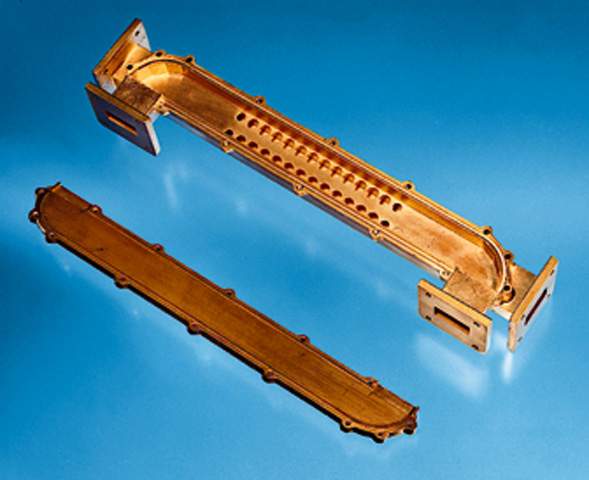Casting Study: Microwave Guides (5 configurations)
 Wave guides are built to exacting specifications in dimensional accuracy, straightness, and flatness. Hot chamber die casting enables critical cavity sections to be cast with little or no draft; very difficult in aluminium cold chamber die casting. Flatness tolerance on the wave guides is held to within 0.002 in. over the entire length. Die casting the wave guides is an extremely cost efficient manufacturing process. A wave guide set that would potentially cost $500 as a finished, machined set costs $75-$100 as a finished zinc casting set, and a significant portion of that cost is in the gold plating. With this kind of differential, tooling costs are recouped in as few as 100 parts, but on average, tooling payback ranges from between 500 and 1,000 pieces.
Wave guides are built to exacting specifications in dimensional accuracy, straightness, and flatness. Hot chamber die casting enables critical cavity sections to be cast with little or no draft; very difficult in aluminium cold chamber die casting. Flatness tolerance on the wave guides is held to within 0.002 in. over the entire length. Die casting the wave guides is an extremely cost efficient manufacturing process. A wave guide set that would potentially cost $500 as a finished, machined set costs $75-$100 as a finished zinc casting set, and a significant portion of that cost is in the gold plating. With this kind of differential, tooling costs are recouped in as few as 100 parts, but on average, tooling payback ranges from between 500 and 1,000 pieces.
Adding to cost efficiency is the elimination of secondary operations. By casting the wave guides in zinc as opposed to aluminium, post-casting straightening is eliminated, while small holes, submarine, and other small cores are cast-in. The zinc die cast wave guides provide additional cost savings after they are delivered to the electronics laboratory where the microwave circuits are tuned. Even though machining produces tight tolerances, dimensions may vary from part to part. Die casting controls dimensions not only within a whole unit, but also part to part. It might take hours, even days, to tune a single microwave system utilizing machined wave guides; however, once parameters are set for the zinc wave guide system, tuning can be accomplished in as little as 15 minutes. Zinc alloy guides also serve as a heat sink, dissipating heat as the microwave signals pass through.